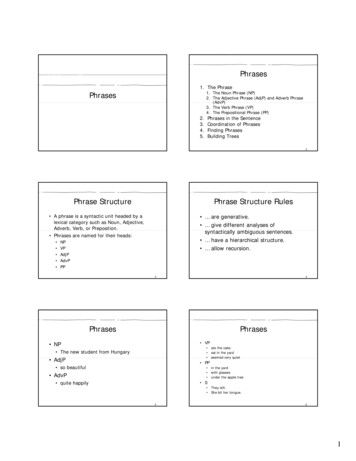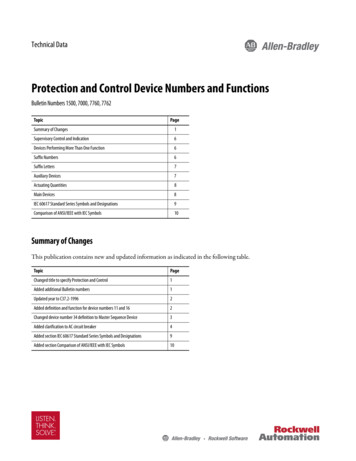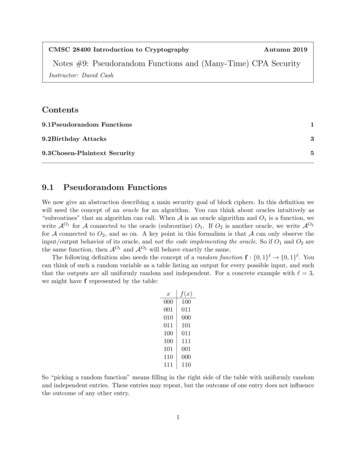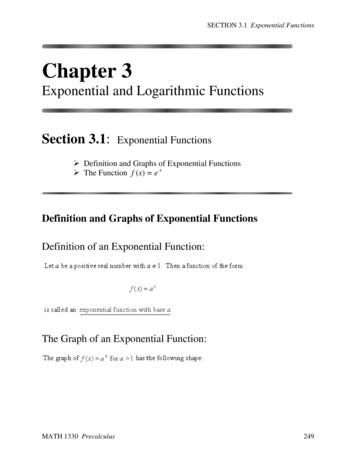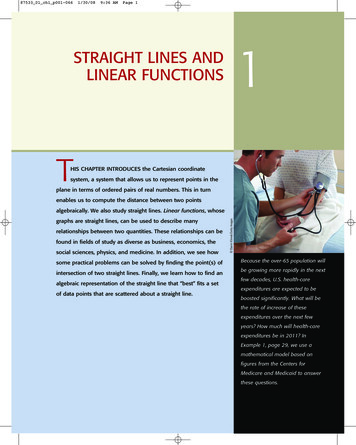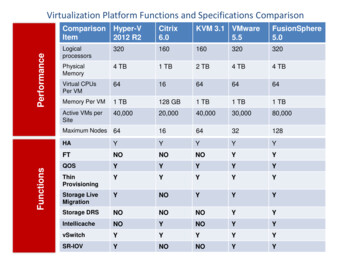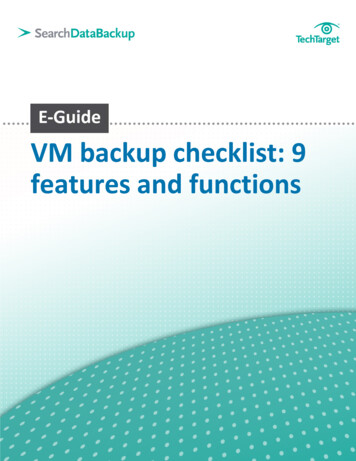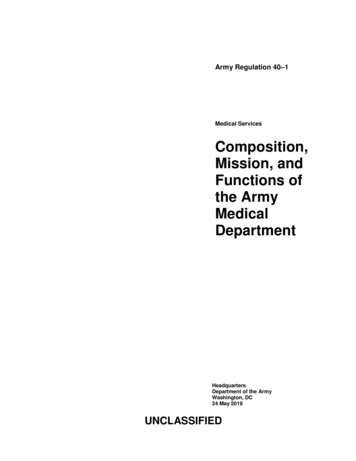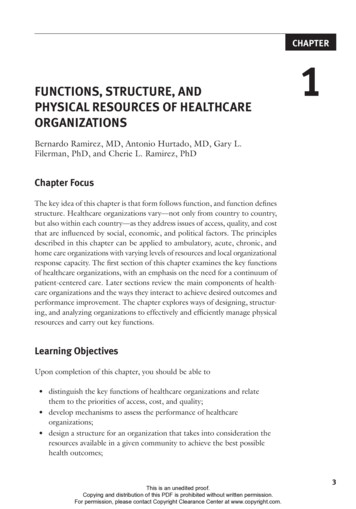
Transcription
CHAPTERFUNCTIONS, STRUCTURE, ANDPHYSICAL RESOURCES OF HEALTHCAREORGANIZATIONS1Bernardo Ramirez, MD, Antonio Hurtado, MD, Gary L.Filerman, PhD, and Cherie L. Ramirez, PhDChapter FocusThe key idea of this chapter is that form follows function, and function definesstructure. Healthcare organizations vary—not only from country to country,but also within each country—as they address issues of access, quality, and costthat are influenced by social, economic, and political factors. The principlesdescribed in this chapter can be applied to ambulatory, acute, chronic, andhome care organizations with varying levels of resources and local organizationalresponse capacity. The first section of this chapter examines the key functionsof healthcare organizations, with an emphasis on the need for a continuum ofpatient-centered care. Later sections review the main components of healthcare organizations and the ways they interact to achieve desired outcomes andperformance improvement. The chapter explores ways of designing, structuring, and analyzing organizations to effectively and efficiently manage physicalresources and carry out key functions.Learning ObjectivesUpon completion of this chapter, you should be able to distinguish the key functions of healthcare organizations and relatethem to the priorities of access, cost, and quality; develop mechanisms to assess the performance of healthcareorganizations; design a structure for an organization that takes into consideration theresources available in a given community to achieve the best possiblehealth outcomes;This is an unedited proof.Copying and distribution of this PDF is prohibited without written permission.For permission, please contact Copyright Clearance Center at www.copyright.com.3
4T h e G lo bal He a l th c a re M a n a g e r plan and prioritize the physical resources needed to effectivelyaccomplish the organization’s key functions, taking into account theavailable resources in that particular system; and integrate physical, human, and technological resources to provideappropriate clinical, support, managerial, and supply chain servicesin a healthcare organization, taking into consideration all legal,accreditation, and regulatory mandates.Competencies Demonstrate an understanding of system structure, fundingmechanisms, and the way healthcare services are organized. Balance the interrelationships among access, quality, safety, cost,resource allocation, accountability, care setting, community need, andprofessional roles. Assess the performance of the organization as a part of the health system. Use monitoring systems to ensure that corporate and administrativefunctions meet all legal, ethical, and quality/safety standards. Effectively apply knowledge of organizational systems, theories, andbehaviors. Demonstrate knowledge of governmental, regulatory, professional, andaccreditation agencies. Interpret public policy, and assess legislative and advocacy processeswithin the organization. Effectively manage the supply chain to achieve timeliness and efficiencyof inputs, materials, warehousing, and distribution, so that suppliesreach the end user in a cost-effective manner. Adhere to procurement regulations in terms of contract managementand tendering. Effectively manage the interdependency and logistics of supply chainservices within the organization.Key Terms Facility designHealthcare systemHealth technology assessmentPrearchitectural medicalfunctional program Regionalization SustainabilityThis is an unedited proof.Copying and distribution of this PDF is prohibited without written permission.For permission, please contact Copyright Clearance Center at www.copyright.com.
Chapter 1: Functions, Structure, and Physical Resources of Healthcare Organizations5Key Concepts Facility designFacility managementLow-resource managementMedical equipment Operations managementOrganizational designPerformance improvementPhysical resources managementIntroductionWe can define the most important functions of healthcare organizations usinga systemic analysis inspired by Avedis Donabedian’s (1988) original conceptionof structure, process, and outcomes. Exhibit 1.1 shows how, as the populationand the healthcare organization interact, the system aligns the available orrequired resources to produce the key notions of utilization, access, productivity, efficiency, and effectiveness, which interact to shape the organization’sperformance. Performance, meanwhile, depends on the competent actions ofhealthcare managers and other human resources in the organization.Since the mid-1900s, the functions, responsibilities, and competenciesof healthcare managers have developed in different ways around the world. Inthe United States and Canada, the role primarily developed as a postgraduatespecialty supported by the W. K. Kellogg Foundation under the umbrella ofSTRUCTURERESOURCESPROCESSHEALTH AS A SYSTEMOUTPUTSOUTCOMESHEALTH STATUSHEALTH SERVICESPOPULATIONINDICATORSPRODUCTIVITYSources: Bradbury, and Ramirez-Minvielle (1995); Donabedian (1966).This is an unedited proof.Copying and distribution of this PDF is prohibited without written permission.For permission, please contact Copyright Clearance Center at www.copyright.com.EXHIBIT 1.1Elements of thehealth systemsanalyzed witha systemicapproach
6T h e G lo bal He a l th c a re M a n a g e rhealthcare systemThe arrangementof people,institutions, andresources thatdeliver healthcareservices to meetthe needs of atarget population.The system’sframework alignsresources tosupport the keyperformancedomains ofaccess, utilization,efficiency, quality,sustainability, andlearning.the Association of University Programs in Health Administration (AUPHA).A handful of university programs were established in 1948. As demand grewand the healthcare field expanded, new graduate and undergraduate universityprograms developed in a number of schools related to health or managementdisciplines (Counte, Ramirez, and Aaronson 2011).Around the world, a number of countries—and a number of locationsinside countries—have developed a strong alignment of professional healthcaremanagers across healthcare organizations; other locations, however, have almostno notion of healthcare management as a profession. In some countries, cliniciansare promoted to serve in managerial roles at healthcare organizations withoutfirst having had the opportunity to acquire management competencies (Westet al. 2012). The International Hospital Federation (IHF) has created a specialinterest group in health management to promote the professionalization of thediscipline and the use of a leadership competency framework to improve theimpact of managers at all levels of organizations and health systems (IHF 2015).The main functions of healthcare systems and organizations in thecontinuum of care are financing, provision of health services, stewardship, andresource development (Frenk, Góméz-Dantes, and Moon 2014). Of thesefunctions, provision of health services and resource development are key, andthey are the ones further explored in this chapter. Provision of health servicesstarts with sound planning and effective/efficient organization. Financing isaddressed in chapters 2 and 3, and stewardship is discussed in chapters 6 and 11.The Performance of Health Systems: Six Core DomainsHealthcare organizational performance around the world was the focus of anextensive study sponsored by the World Bank, in which investigators conducteda thorough literature review and developed a guide to concepts, determinants,measurement, and intervention design (Bradley et al. 2010). The World Bankreport examined six core performance litySustainabilityLearningThe first four domains are related to the “iron triangle” of healthcare, a conceptthat was introduced by Kissick (1994) and later provided the basis for the “tripleThis is an unedited proof.Copying and distribution of this PDF is prohibited without written permission.For permission, please contact Copyright Clearance Center at www.copyright.com.
Chapter 1: Functions, Structure, and Physical Resources of Healthcare Organizationsaim” initiative developed by the Institute for Healthcare Improvement (IHI).Kissick’s iron triangle consists of access, quality, and cost containment, whereasthe IHI’s “triple aim” adds the dynamics of population health (IHI 2012).Access incorporates several dimensions—physical access, financial access,linguistic access, and information access—that are supplemented by serviceavailability and the provision of nondiscriminatory services. Equitable treatment should be provided regardless of gender, race, ethnicity, religion, age,or any other physical or socioeconomic condition. Utilization includes dimensions of patient or procedure volume relative to capacity or population healthcharacteristics. Efficiency is determined by cost- or staff-to-service ratios andby patient or procedure volume. Quality includes clinical and managementquality, as well as patient experience.The last two domains—sustainability and learning—are key to ensuringconstant, self-propelled growth in an ever-changing, complex environment suchas healthcare. Sustainability in healthcare can be defined as “the capacity ofhealth services to function with efficiency, including the financial, environmentand social interaction that guaranties an effective service now and in the future,with a minimum of external intervention and without limiting the capacity offuture generations to fulfill their needs” (Ramirez, Oetjen, and Malvey 2011,134). Sustainability can be considered from two distinct perspectives or dimensions. The first perspective focuses on the sustainability of processes that createa basic functional network throughout the organization, allowing for flexibilityand quality improvement—both of which are necessary for the dynamic changeenvironment of healthcare. The second perspective deals with organizationalsustainability, and it includes five multidimensional pillars:1. The environmental pillar represents the initial point of focus forsustainability, and it includes—but is not limited to—the use of cleanand renewable energy and the conservation of the natural environment.This pillar incorporates recycling techniques to preserve the quality ofthe atmosphere, to reuse solid and liquid waste, and to safely dispose ofcontaminants.2. The sociocultural pillar strengthens community support and promotesthe identification of key cultural, ethnic, and other values among thecommunity of staff, patients, and users. It incorporates populationhealth and social marketing strategies.3. The institutional capacity development pillar promotes the strategicmanagement of the organization. It aims to strengthen competenciesat all levels and instill an empowering knowledge management culture,facilitating coordinated efforts of governance, leadership, and personnelintegration and participation.This is an unedited proof.Copying and distribution of this PDF is prohibited without written permission.For permission, please contact Copyright Clearance Center at www.copyright.com.7sustainabilityThe capacityfor a healthcareorganization tofunction efficientlyand in a mannerthat supportseffective serviceboth presently andin the future.
8T h e G lo bal He a l th c a re M a n a g e r4. The financial pillar ensures the delivery of healthcare programs andactivities that are cost effective and efficient in the use of resources. It isindispensable for achieving the organization’s goals and objectives.5. The political pillar involves staff, patient, and community advocacy toadvance the interests of the organization.Finally, the learning domain empowers the organization to adapt tochange and to explore and adopt innovations. It incorporates efforts to use dataaudit and feedback processes, to distribute relevant information and providepatient education through partnerships with the constituency, and to implement training and continuing education initiatives for the healthcare workforce.The Challenge of Organizing Health Services Resourcesto Achieve Optimum PerformanceThe provision of universal access to optimal prevention, care, cure, and rehabilitation can be considered an ultimate goal of healthcare. Most governments,either directly or indirectly, subscribe to this goal; the challenge is—given thelimitations of resources and entrenched infrastructure—achieving the greatestpossible return on the investment toward reaching it. All countries, regardless of their level of wealth or industrialization, are limited in their ability toachieve this goal, often because of political philosophies expressed as publicpolicy. Even those nations in the most favorable positions often lack the willor capacity to translate their knowledge of what is possible into practice forthe benefit of all people.Over many years of technological development and interaction amongprofessional, political, and economic forces, three enduring organizational focihave emerged for achieving the optimum health status for a population. Theyare (1) hospitals, (2) primary care provision, and (3) regionalization.HospitalsIn every country, hospitals are the most visible symbol of healthcare development and care for the sick. They represent public assurance that there is a placefor people to go for care when needed. Hospitals are also important economicengines, generating employment and anchoring the economies of communities.They consume a large portion of the health sector resources in many countries.The hospital is arguably the most complex contemporary organizationto manage. Hospitals, particularly in developing countries, struggle internallywith inadequate management and governance; limited sources of income;insufficient human resources; poorly planned, financed, and maintained physical plants; and rudimentary quality controls. At the same time, they are oftenThis is an unedited proof.Copying and distri
ment training and continuing education initiatives for the healthcare workforce. The Challenge of Organizing Health Services Resources . to Achieve Optimum Performance. The provision of universal access to optimal prevention, care, cure, and reha-bilitation can be considered an ultimate goal of healthcare. Most governments,
